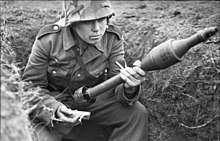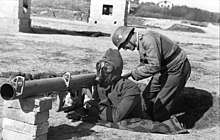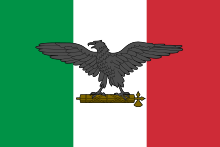Panzerschreck
Panzerschreck (lit. "tank fright", "tank's fright" or "tank's bane") was the popular name for the Raketenpanzerbüchse 54 ("Rocket Anti-armor Rifle model 54" abbreviated to RPzB 54), an 88 mm reusable anti-tank rocket launcher developed by Nazi Germany in World War II. Another earlier, official common name was Ofenrohr ("stove pipe").[1]
| Panzerschreck | |
|---|---|
 The improved Raketenpanzerbüchse 54 with blast shield. | |
| Type | Anti-tank rocket launcher |
| Place of origin | Nazi Germany |
| Service history | |
| In service | spring 1944–1945 (Nazi Germany) |
| Used by | See Users |
| Wars | World War II |
| Production history | |
| Unit cost | 70 Reichmark |
| No. built | 289,151 |
| Variants | RPzB 54, RPzB 54/1 |
| Specifications | |
| Mass | 11 kilograms (24 lb) empty (RPzB 54) with shield |
| Length | 164 centimetres (65 in) |
| Caliber | 88 mm |
| Muzzle velocity | 110m/s (360 ft/s, 246 mph) |
| Effective firing range | 150 m (RPzB 54) |
The Panzerschreck was designed as a lightweight infantry anti-tank weapon and was an enlarged copy of the American bazooka.[2] The weapon was shoulder-launched and fired a fin-stabilized rocket with a shaped-charge warhead. It was made in smaller numbers than the Panzerfaust, which was a disposable recoilless gun firing an anti-tank warhead.
History



The Panzerschreck development was initially based on the American bazooka, captured in Tunisia, February 1943. The Panzerschreck was larger and heavier than its American counterpart - the Panzerschreck had an 88 mm calibre, compared to the 60 mm calibre of the bazooka - which meant that it could penetrate thicker armor, but also produced more smoke when firing.
Calibre 88 mm was selected as the existing RPzB. Gr. 4312 for 8.8 cm Raketenwerfer 43 was reused for Panzerschreck. Warhead and fuzing was carried over, but the rocket motor's housing needed lengthening from 490 mm (19 in) to 650 mm (26 in) to accommodate the longer rocket motor. Raketenwerfer 43 had percussion firing, whereas for the Panzerschreck an electrical priming was selected, forming standard grenade RPzB. Gr. 4322.[3] Other munitions were developed, including drill dummy, practice live rocket with inert warhead and standard grenade with improved contact system.[4]
The earliest production model of the RPzB 54 was 164 centimetres (5.38 ft) long and weighed about 9.25 kilograms (20.4 lb) when empty. Unlike the rockets used in American bazookas which extinguished before leaving the tube, the RPzB rockets kept burning for about 2 metres (6.6 ft) after exiting the tube. Users were instructed to wear heavy gloves, a protective poncho and a gas mask without a filter to protect them from the heat of the backblast when the weapon was fired.[5] Improvised shields were made to protect the user and in February 1944, the RPzB 54 was fitted with an official blast shield to protect the operator which made the weapon heavier, weighing 11 kilograms (24 lb) empty. Small numbers of the shortened RPzB 54/1 were later produced. It had an improved rocket, a shorter barrel, and a range increased to about 180 metres (590 ft).[1]
Firing the RPzB generated a copious amounts of smoke both in front of and behind the weapon. Because of the weapon's tube and smoke produced, official documentation named the weapon the Ofenrohr ("stove pipe"). This also meant that anti-tank teams were revealed once they fired, making them targets and, therefore, required them to shift positions after firing. This type of system also made it problematic to fire the weapon from inside closed spaces (such as bunkers or houses), filling the room with toxic smoke and revealing the firing location immediately.
Late war German tactical doctrine called for Panzerschreck and/or Panzerfaust teams to set up in staggered trenches no further than 115 metres (377 ft) apart. In this way, attacking armor would face anti-tank fire from multiple directions at a distance of no more than 69 metres (226 ft). Anti-tank teams were instructed to aim for the thinner side or rear armor whenever possible.[6] Allied armored units frequently attempted to add improvised protection to their tanks, e.g., sandbags, spare track units, logs and so on to protect against HEAT rounds. Another defense was to rig metal mesh and netting around the tank, resembling the German Schürzen auxiliary plates. In practice about 1 meter of air gap were required to substantially reduce the penetrating capability of RPzB, thus skirts and sandbags were virtually entirely ineffective against RPzB and Panzerfaust.[7]
In 1944, Germany provided the Panzerschreck to Finland, which used it to great effect against Soviet armour. The Finnish name for the weapon was Panssarikauhu (literal translation of the German name).
The Italian Social Republic and Hungary also used the Panzerschreck. Several Italian units became known as skilled anti-tank hunters and the Hungarians used the Panzerschreck extensively during Operation Spring Awakening.
Performance
Penetration measured against Face-Hardened Armor (FHA), Rolled Homogeneous Armor (RHA).
| Testing nation | Armor | Angle | Penetration |
|---|---|---|---|
| Germany | RHA | 90° | 230mm[8] |
| Germany | RHA | 60° | 160mm[9][10] |
| Germany | RHA | 30° | 95mm[11][12] |
| Finland | FHA | 30° | 100mm[13] |
| United States | FHA | 90° | 216mm[14] |
| United States | FHA (6") + RHA (2.25") | 90° | 210mm[15] |
Users
.svg.png)


.svg.png)


.svg.png)
See also
References
- Bishop, Chris (1998). The Encyclopedia of Weapons of World War II. New York: Orbis Publishing Ltd. p. 206. ISBN 0-7607-1022-8..
- Zaloga, Steven (22 September 2008). Armored Thunderbolt: The U.S. Army Sherman in World War II. p. 90–93. ISBN 9780811742443.
- Gordon L Rottman; Johnny Shumate; Alan Gilliland (20 August 2014). Panzerfaust and Panzerschreck. Osprey Publishing. pp. 29–30. ISBN 978-1-78200-790-6. Retrieved 10 September 2015.
- "The Panzerschrek Ammunition". www.bergflak.com. 9 May 2015. Retrieved 10 September 2015.
- Fleischer, Wolfgang. Panzerfaust: And Other German Infantry Anti-Tank Weapons. Schiffer Pub Limited, 1994, ISBN 9780887406720, p. 39
- Bull, Stephen (5 February 2005). World War II Infantry Tactics (2): Company and Battalion. p. 45–46. ISBN 9781841766638.
- Chamberlain, Peter (1974). Anti-tank weapons. Arco. ISBN 0668036079.
- "Finnish Army 1918 - 1945: Infantry At-Weapons Part 2".
- "Finnish Army 1918 - 1945: Infantry At-Weapons Part 2".
- Karl. R. Pawlas, Dokumentation W 127 pg.75
- "Finnish Army 1918 - 1945: Infantry At-Weapons Part 2".
- Karl. R. Pawlas, Dokumentation W 127 pg.75
- "Finnish Army 1918 - 1945: Infantry At-Weapons Part 2".
- Catalog of Enemy Ordnance Materiel pg.357
- German and Japanese Solid-Fuel Rocket Weapons, pg.8
- Rottman, Gordon L. (2014). "The Panzerfaust and Panzerschreck in other hands". Panzerfaust and Panzerschreck. Osprey Publishing. pp. 68–69. ISBN 9781782007883.
- Tibor, Rada (2001). "Német gyalogsági fegyverek magyar kézben" [German infantry weapons in Hungarian hands]. A Magyar Királyi Honvéd Ludovika Akadémia és a Testvérintézetek Összefoglalt Története (1830-1945) (in Hungarian). II. Budapest: Gálos Nyomdász Kft. p. 1114. ISBN 963-85764-3-X.
- "WorldWar2.ro - Soldat Traiam Giurgelea - amintiri din Moldova".
External links
| Wikimedia Commons has media related to Panzerschreck. |